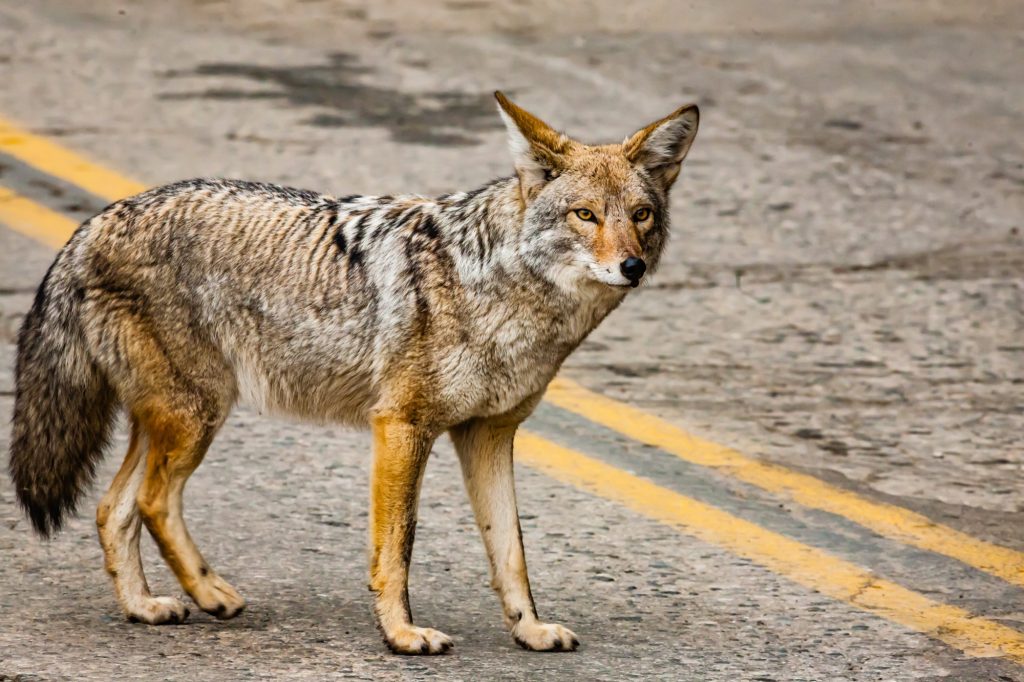TOWN BANK – A Lower Township resident reached out to the Herald recently, expressing concern over the presence of coyotes in his neighborhood.
Edward Myers, of Town Bank, said he saw a large coyote walking down Cliffside Road in the middle of the afternoon and became concerned. Myers, 80, said he is particularly concerned for his wife and their Yorkshire terrier when they are out for walks in the neighborhood. He said he is worried about any small pets and small children in the neighborhood, who might fall prey to “packs of coyotes.”
A July 8, 2021, New Jersey Conservation Foundation article titled, “Co-existing with wily coyotes,” quoted Christian Crosby, a Ph.D candidate in the Rutgers University Department of Ecology. In the article, it says coyotes are not pack animals, and their social unit consists of a mated pair, their pups, and perhaps a teenager offspring from the previous year’s litter.
This contradicts a claim made by a Lower Township resident in November 2021, who told Lower Township Council that a “den of over 70 coyotes right behind Channel Apartments” has been found. A den normally refers to the place where wild animals live, whereas a pack refers to a social group.
The Herald reached Crosby Jan. 17 and asked him about the claim that there was such a large pack of coyotes in one place in Lower Township.
“Generally, coyotes don’t pack up. They are like wolves in some relationships, but a pack of 70 would be unheard of,” Crosby said.
Crosby, who is still working on a Ph.D in ecology and evolution, was out collecting cameras along the coast when he spoke to the Herald. He said nothing he had read or seen would indicate a pack of 70 coyotes was possible.
“Even wolves top out at about 20. For 70, the (food) resources would be immense,” Crosby said.
Coyotes, he said, move around in solitude and generally hunt in solitude. He said a coyote social unit would be as noted, but perhaps with a couple of young males that paired with daughters of the mated couple.
Myers said he was told the State of New Jersey transported coyotes into Cape May County; however, the New Jersey Division of Fish and Wildlife website addresses this, saying, “Contrary to public opinion, Fish and Wildlife has never imported coyotes at any time in the past, although there is evidence that private citizens throughout the state have done so prior to 1950.”
Crosby said there are a lot of rumors that circulate about coyotes, and they tend not to be logical. He said he heard they were introduced to take care of a rodent problem, but he has talked to biologists at the Fish and Wildlife office, and they have no record it ever happened. The rumor that the state introduced larger coyotes to chase off smaller coyotes is also not logical.
Crosby said, in general, coyotes are wide-ranging. The history of the eastern coyote indicates they traveled from the west to the east, where they interbred with both grey wolves and domestic dogs.
Crosby said coyotes generally spread out and that as males grow, they tend to be kicked out of the range area of the parents. He said that helps to prevent inbreeding, but as a result, males can wander dozens or even hundreds of miles from where they were born.
A Rutgers Cooperative Extension bulletin, co-authored by Crosby, says that the first documented sighting of a coyote in New Jersey was in 1939 in Hunterdon County, and the first verified report occurred in 1948 in Cape May County. The bulletin says coyotes have been reported in 453 of New Jersey’s 566 municipalities, and have been reported in all 21 counties, covering 96% of New Jersey’s land area.
“That report is from 2012, so it’s undoubtedly 100% by now,” Crosby said.
Crosby said in a place such as Cape May County, coyotes tend to sequester until there is less activity, such as in the winter months, but they will go out when they need to.
He said he believes the number of coyotes is rather consistent in Cape May County, including on the barrier islands. He said as the coyote population increases, they are more comfortable in expanding their territory, so coyotes are likely to be in every town in the state at this point.
When asked if coyotes are a danger to pets, Crosby said if people have outdoor cats and dogs and if the coyote is hungry enough, or there is too much competition for food, it will attack. Again, he said that would be rare. Attacks on people are even rarer.
“Generally, coyotes only interact with humans when a person habitually feeds the coyote, intentionally or not intentionally,” Crosby said.
Unintentional feeding could be from pet food bowls placed outside or even garbage in open containers. He said if people are intentionally feeding coyotes, the animals could lose their fear of people and see people as a source of food. Then, if people stop, that could lead to conflict.
“Again, that is very rare,” Crosby said.
Crosby noted that a starving or rabid coyote might possibly attack, but rabies in coyotes is very rare.
When asked about the possibility of a coyote attacking a small child, Crosby said the eastern coyote is very timid, and even the noise of a child crying would probably scare it off. To attack a woman walking a dog, he said, a number of things would have to happen.
“It would have to be starving and habituated where it no longer feared the woman or dog and would consider the risk of fighting both the woman and dog,” Crosby said.
Crosby said some of the fear people have toward coyotes is that people have the idea that anything that looks or acts like a wolf will be dangerous. He feels that, in Cape May County, there is generally enough food available so that coyotes would not resort to the rare attack.
Even if their fears are not supported by data, some have suggested that the state relocate coyotes to give people more peace of mind. Crosby said that would not solve the problem.
“If you move a coyote from Cape May County to the Pine Barrens, for example, there will already be a coyote or coyotes there, so the new coyote will either try to return to where it came from or conflict with the wildlife already there,” he said.
However, Crosby said the biggest reason the state is against relocating wildlife is the risk of communicating disease from one area to another. The state also does not want to disrupt the local ecology, of which coyotes are a part.
There is information readily available on the internet to advise people regarding how to coexist with coyotes. Information is available on www.capemaycity.com, www.townshipoflower.org, and https://www.state.nj.us/dep/fgw/coyote_info.htm.
The following guidelines can help reduce the likelihood of conflicts with coyotes:
· Never feed a coyote. Deliberately feeding coyotes puts pets and other residents in the neighborhood at risk.
· Feeding pet cats and/or feral (wild) cats outdoors can attract coyotes. The coyotes feed on the pet food and also prey upon the cats.
· Put garbage in tightly closed containers that cannot be tipped over.
· Remove sources of water, especially in dry climates.
· Bring pets in at night.
· Put away bird feeders at night to avoid attracting rodents and other coyote prey.
· Provide secure enclosures for rabbits, poultry, and other farm animals.
· Pick up fallen fruit and cover compost piles.
· Although extremely rare, coyotes have been known to attack humans. Parents should monitor their children, even in familiar surroundings, such as backyards.
· Install motion-sensitive lighting around the house.
· Clear brush and dense weeds from around dwellings. This reduces protective cover for coyotes and makes the area less attractive to rodents and rabbits. Coyotes, as well as other predators, are attracted to areas where rodents are concentrated, like woodpiles.
· If coyotes are present, make sure they know they’re not welcome. Make loud noises, blast a canned air siren, throw rocks, or spray them with a garden hose.
Coyotes play an important role in the ecosystem, helping to keep rodent populations under control. They are, by nature, wary of humans.
However, coyote behavior changes if given access to human food and garbage. They lose caution and fear. They may cause property damage and threaten human safety, requiring euthanasia.
Relocating a problem coyote is not an option because it only moves the problem to someone else’s neighborhood.
Thoughts? Questions? Contact the author, Christopher South, at csouth@cmcherald.com or 609-886-8600, ext. 128.








